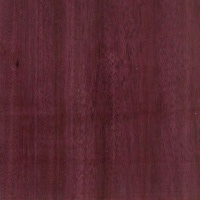|
PRODUCTS
PRODUCTS
|
|
BACK
TO BASICS - THE PHI
CYCLOPS iii C1800®
OUR
ORIGINAL BI-POLAR VOIGT PIPE IS BACK – and much
improved.
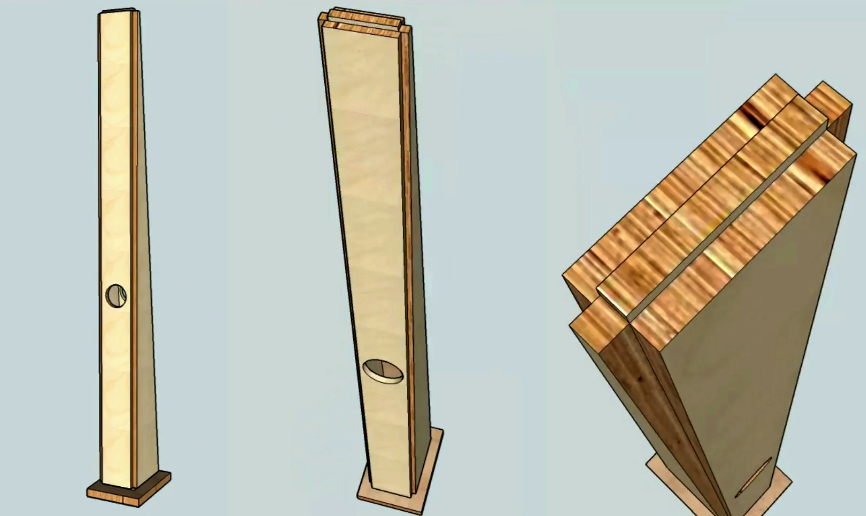
A
concept sketch of the enclosure of the Cyclops III
C1800®
Our
acclaimed Cyclops is back – and much improved. Instead
of the somewhat quirky 3-inch Kevlar driver that was
used at both the
front and the back of the original Cyclops I and II, the
Cyclops III employs a high-end four-inch fullrange
driver in front and and an excellent five-inch driver at
the back. As one would expect the new Cyclops plays much
lower than the original, with tighter bass and almost
double the power rating of the original.
Both
drivers are exceedingly flat and well behaved, which
does away with the need for all filter components. Both
drivers are connected directly to the amplifier, and
when bi-amping, not even a resistor is needed in the
design to address potential baffle step response issues.
One
would expect a pay-off in high-frequency behaviour, but
even that is much improved, with clean and realistic
staging and response across the frequency spectrum.
For
now, we have decided to employ only waterjet-cut,
top-quality Baltic birch plywood. Solid-wood faces will
be limited to bespoke versions of this quite amazing
loudspeaker.
The
Nepenthe Q300®, a smaller and more affordable cousin of
the Cyclops III C1800, is going through final testing at
present.
As
all our products are, this speaker is licensed under the
creative commons as Attribution-NonCommercial-ShareAlike

RETURN
TO TOP
|
|
BACK
TO BASICS - THE PHI
NEPENTHE Q300®
A
QUASI-PERIODIC TAPERED ENCLOSURE
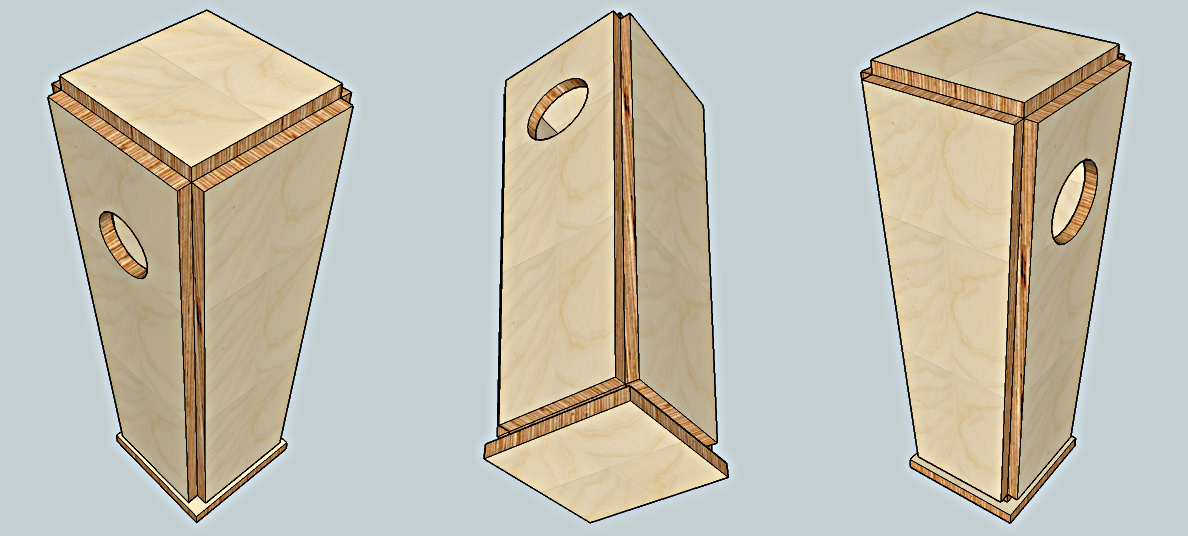
A
concept sketch of the enclosure of the Nepenthe Q300®
Named
after the mythical potion that makes one forget all
grief and suffering, Nepenthe is our answer to the ails,
true or imagined, of parallel-walled enclosures, in
particular the small,
“bookshelf” enclosures named
the CuBE that we periodically construct and use on stage
and in our studio as near-field monitors.
The
driver complement of the Nepenthe Q300 is exactly the
same as what we use in our flagship Cyclops C1800
loudspeakers, but their height of around 700mm make them
much easier to accommodate in smaller listening
environments – typically with no or only a minimal
stand.
In
terms of performance, they
are very hard
to beat – on paper their response
is almost exactly the same as that of the much larger
Cyclops, and in listening tests it is hard to
distinguish between the two, in spite of the slight edge
in tonal refinement that the Cyclops shows.
A
smaller enclosure uses far less materials and is easier
to manufacture, which translates to a meaningfully
smaller price tag for the Nepenthe than
what the Cyclops comes with.
Again,
as all our products are, this speaker is licensed under
the creative commons as
Attribution-NonCommercial-ShareAlike

RETURN
TO TOP

be[spoke]
GALLERY
THE
PHI SHOWCASE
Below
is a display of bespoke
loudspeakers we
have designed and manufactured for specific customers.

Ranging
from super-detailed 3 inch driver systems to heftier 2.1
meter tall 6.5 and 8 inch driver high-sensitivity
loudspeakers, this abbreviated list gives an indication
of our styles and capabilities.

|
|
Cyclops
MLTQWT - 2007
High-detail
bipolar audiophile loudspeaker system.
The
Cyclops was our inaugural be[spoke]
loudspeaker.
Medium sensitivity (90dB/2.83V) serial filter network
plus line level response filter with a modest power
handling of 40W RMS per loudspeaker unit.

This
loudspeaker was very well received by the media and
still acts as a benchmark for our larger
loudspeakers.
Our
be[spoke]
range
will have a similar
loudspeaker
soon.

|
|
downPHI®
MLTQWT - 2008
High-detail
bipolar audiophile loudspeaker system.
The
downPHI®
was a simple evolution of our Cyclops loudspeaker -
mainly to simplify construction and to incorporate the
filter network into the loudspeaker. It incorporates a
unique down firing port to effect omni-directional
loudspeaker port output.

The
performance, both objectively and subjectively, was very
similar to that of the Cyclops and the small differences
between the two types have at times appealed to some
listeners and at other times made almost no difference
to their impressions.

|
|
Naledi
DTTP - 2009
Ultra
low bass audiophile loudspeaker system.
The
Naledi was our first foray into Double Taper Tuned Pipe
(DTTP) territory, a system devised by PHI to obtain a
larger tuned length than a typical ceiling would allow,
in order to exact very low bass performance from
modestly sized 5.5 inch drivers.

Bass
response extended into the high teens of Hz at around
90dB/2.83V sensitivity and 35 Watt power handling.
This
speaker formed the base of our current Siderium
be[spoke] loudspeaker.

|
|
Yggdrasil
MLTQWT - 2009
High-sensitivity
dual-cone audiophile loudspeaker system.
The
Yggdrasil is our second largest loudspeaker to date,
standing 2.1m tall. It employs the same port system as
the downPHI®
but
has a much higher sensitivity of close to 95dB/2.83V.

Power
handling is a still modest 30W RMS per speaker, belied
by its authoritative and liquid delivery, even when
powered by flea-power 5 Watt valve amplifiers.

|
|
phISH
ISHTQWT - 2010
Affordable
audiophile loudspeaker system.
The
phISH use what we refer to as an intensated short horn
TQWT - a pipe with a relatively short tuned length using
a traditional port to effect the last bit of bass
extension.

What
this enables one to do is to make a much shorter
loudspeaker without influencing performance too much.
This speaker employs three identical 4 inch fullrange
drivers, two on the front baffle and one on the rear,
with a neodymium silk dome supertweeter. Sensitivity is
around 91dB/Watt at a power handling of 100W RMS.
A
very listenable and versatile loudspeaker on which one
of our per[form]
models
is
based.

|
|
e.phISH
ISHTQWT - 2011
Extended
affordable audiophile loudspeaker system.
The
e.phISH is a slightly taller version of the phISH.
Performance is almost identical with perhaps a slightly
more extended low end (-5dB at around 47Hz instead of
50Hz).

Very
listenable and matches almost any front end. Also a
keeper.

|
|
Siderium
DTTP
Ultra-Low
Bass Stereo Audiophile Loudspeaker System.
The
Siderium is our be[spoke]
loudspeaker for
the purist. Constructed from solid American walnut, it
excels in any kind of music and has bass extension and
clarity far beyond what would be possible with
traditional designs. The unique DTTP (Double Taper Tuned
Pipe) design is a world first and provides a level of
realism, involvement and immediacy that compares with
that of any loudspeaker, at any price point.
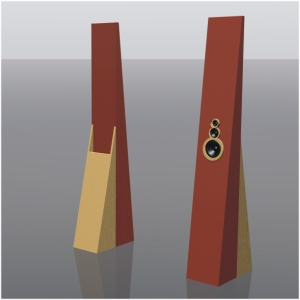
Concept
sketch of the Siderium DTTP
RETURN
TO TOP
|
|
NEW
DESIGNS
NEW
DESIGNS
|
|
|
|
On
the work bench: The Serpula
– a
tapered transmission line loudspeaker
Boundary-mounted
Mono
Loudspeaker System
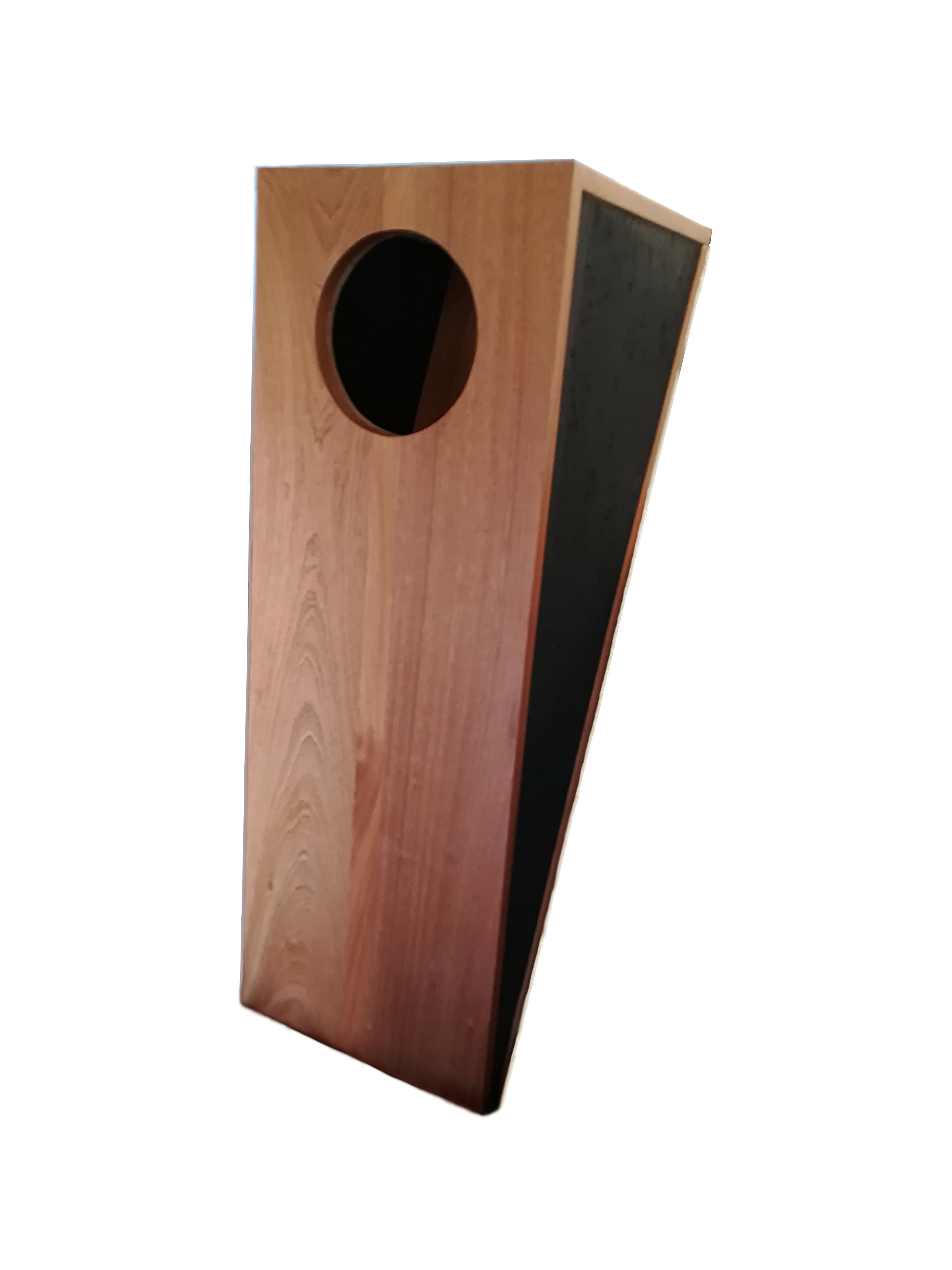
Above:
a photo of the case of this new design.
The
name Serpula derives from a genus of calcareous marine
tubeworms. It was chosen to indicate the fact that this
entire range of loudspeakers has been optimised for
mounting against a boundary or wall. The present example
will be an event loudspeaker aimed at professional sound
reinforcement, but will soon be followed by similarly
styled designs for high-end home audio use. Construction
materials for the top, face and back comprise a laminate
of solid 22mm African Mahogany with MDF, and the sides
are made of similarly reinforced OSB. The downward
tapering geometry is purely functional and a set of two
carefully selected 8-inch pro-audio drivers, one a
coaxial unit and one a Kevlar bass driver, will complete
the picture. Features include sensitivity in excess of
96dB/2.83V at 1m, 350W RMS power handling, an easily
driven load impedance, and a minimal first-order
crossover network.
RRP
= n/a (prototype)

THE
SERPULA SSS
Freshly
off the design bench:
The Serpula -
a wall-mounted transmission-line/reflex enclosure
hybrid.
Wall-Mounted
Stereo
Audiophile Loudspeaker System.
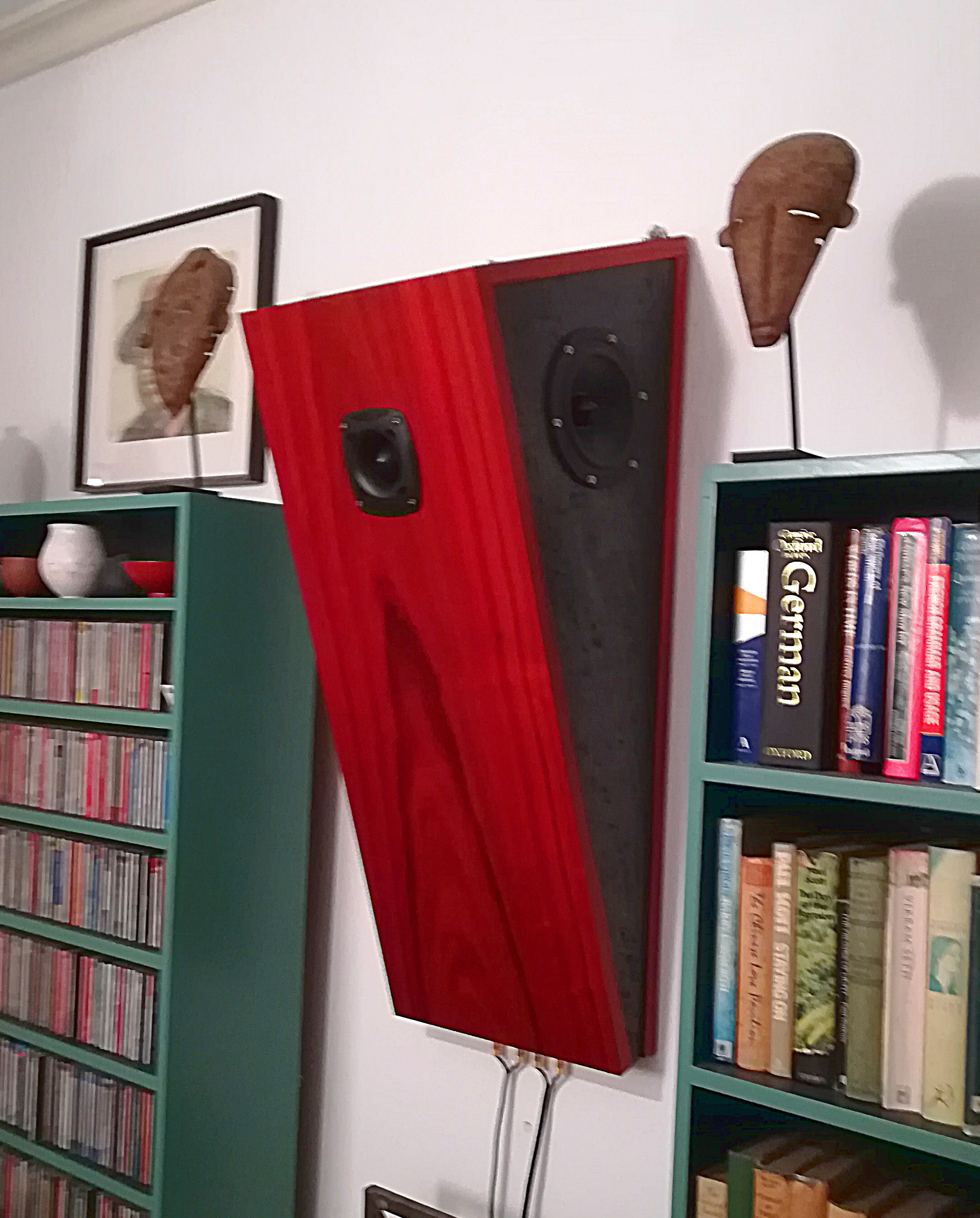
Above:
the prototype of the new Serpula Single-Speaker-Stereo
loudspeaker, installed in a client’s lounge.
As
second offering from our new per[form] stable,
the new Serpula design is a hybrid of a short-taper
tuned pipe and a standard reflex enclosure. The
German-designed high-end fullrange driver uses the tuned
pipe character of the enclosure to firm up its lower
frequency response and excursion characteristics, while
the American- or Italian-designed audiophile low
frequency driver, which only operates at full efficiency
between around 40Hz to 150Hz, uses the reflex
characteristics of the enclosure to firm up its
low-frequency response. A high quality, low-slope
first-order serial crossover filter assures immaculate
integration of the two drivers.
The
loudspeaker is made to be mounted relatively high
against a wall – this is as much a concession to space
considerations as to inevitable boundary fall-off in
modern, smaller home spaces, but simulations have shown
that this configuration not only has a positive, though
minimal, effect on the sound character of the fullrange
driver, but is substantially advantaged by the low
frequency boost that accompanies the placement of a
loudspeaker against a boundary/wall. The upward-firing
driver (in case of the stereo set) augments this boost
effect by acoustically coupling with the ceiling.
The
design employs solid hardwood for the face, back and top
of the loudspeaker, and an OSB/MDF sandwich for the
sides. 25mm of solid Padauk wood, reinforced with a 9mm
layer of MDF, was employed in the example above.
The
loudspeaker has been tested with a range of drivers in
various cost brackets and performs exceptionally with
all of the drivers we have selected. This not only
allows customisation, but makes possible an entry-level
model of this hugely enjoyable and musical loudspeaker.
RRP
= R17,000.00 *
*
The stereo pair will retail at around R30,000.00
|
|

NEWCYCLOPS
|
THE
NEW CYCLOPS
Our
Flagship, the Cyclops, is Back – simpler, more powerful, even
better than before.
Floor-standing
Stereo
Audiophile Loudspeaker System.
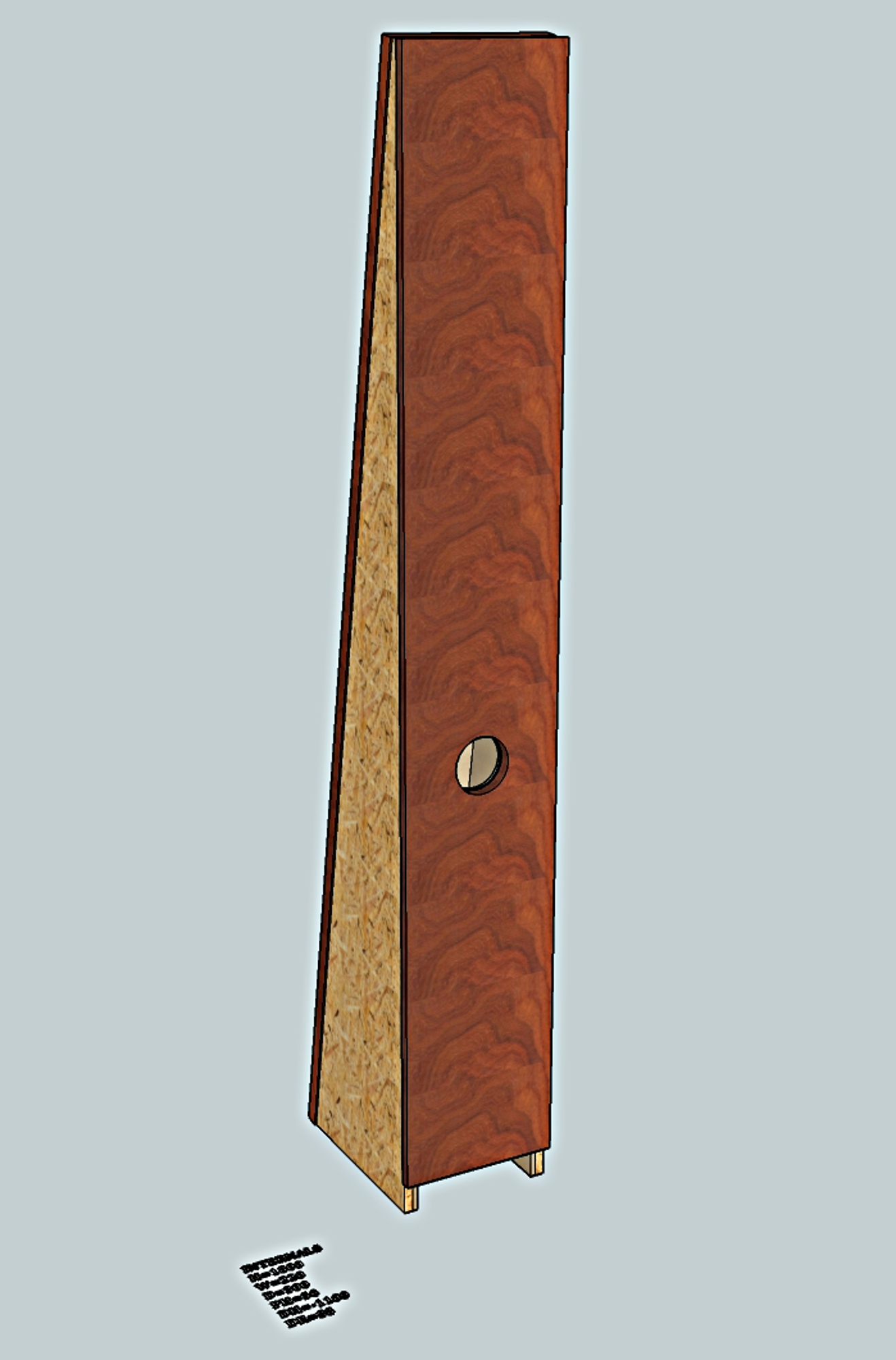
Above:
concept sketch of the shell of the new Cyclops.
As
minimal as we can dare to be, the Cyclops now accepts a range of
drivers, not just the little 3-inch Kevlar driver that one has become
accustomed to. The aesthetics reflects our recent approach, as
evident in the Serpula range: every aesthetic decision is based on a
technical reason. Not a single aspect has not been rethought a few
times, and every change was tested to exhaustion. If you have the
space for 2m tall Voigt Pipes, this is the best that PHI offers.
RRP
= will be strongly dependent on driver choices and will start at
around R38,000.00 a pair.

|
|
UPCYCLING
UPCYCLING
OLD FAVOURITE LOUDSPEAKERS
|
|
Reimagining
the Past – PHI’s Loudspeaker Upcycling Project
Expanding
the augmented fullrange driver idea to damaged or
abandoned speakers

To
follow: an image of the re-imagined JPW P1.
When
a client’s old but trusty set of JPW P1 loudspeakers
landed in our workshop, it was hard not to start
fiddling around with drivers. Soon it had a 3-inch Tang
Band driver instead of the tweeter it came with, and a
modified crossover to suit the new alignment. Not long
after, the tweeter was back, now as an upward-firing
supertweeter, crossed in at 25kHz. It sounds so good
that we have decided to add loudspeaker upcycling to our
work portfolio.
Please
enquire at upcycled@phi-audio.com
if you have a set of speakers you want new life blown
into.

|
|
|
|
HISTORY
HISTORY
- THE CYCLOPS
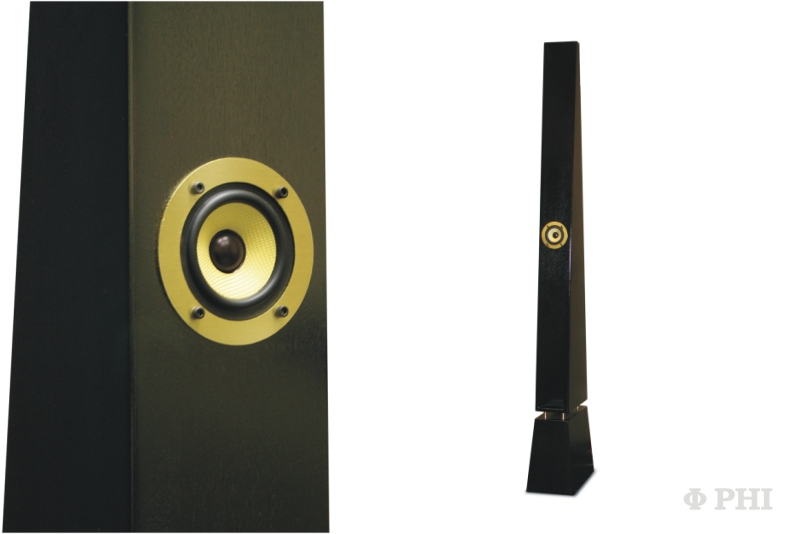
-
|
The
Cyclops was PHI's first commercial loudspeaker. It came
about after a lengthy search for drivers for a tapered
quarterwave pipe, itself intended to display the virtues of
the Sonic Impact T-Amp. We found that this little amplifier
simply couldn't drive the ported boxes we had at hand and
the intention was to build a pair of high-efficiency
loudspeakers with small fullrange drivers. An almost
impossible feat, we realised.

The
Sonic Impact T-Amp
The
initial Cyclops was a spare-no-expense solution to building
a loudspeaker around these 75mm Kevlar drivers, able to
outperform commercial loudspeakers priced up to ten times
higher than our intended sale price. It was a tall order,
but we pulled it off. Measuring 91dB/Watt at 1m, the
efficiency couldn't exactly be called high. But it was high
enough to do the T-Amp justice and it was just about as
much as one could coax out of a 3 inch driver without using
a impractically large horn.

The
initial Cyclops had a concrete base with cavities filled
with lead shot. The enclosure was entirely hand-made from a
sandwich of MDF and solid Sapele mahogany; the filter box
from beech, Panga-panga and glass. This elaborate filter
and crossover box sported a custom designed adjustable
MOSFET pre-amplifier as well as high quality passive
crossover components. Interconnects were custom designed;
NOS vintage components were used. At one point we counted
four rare earth metals in the design. It was, in short, a
lot of hard, expensive work.
Reviews
were flattering to the extent that the Cyclops is still in
production.

The
downPHI®
The
original was a tough act to follow. We created the downPHI®
from the original Cyclops – a bit taller and sleeker and
in some ways better. We went back to the original but
amended the filter unit, housing many of the components
inside the boxes as one has come to expect. We adapted the
aesthetic to our current two-tone design feel. The
present incarnation of this loudspeaker is much less
elaborate than the original and, predictably, sounds a bit
better. But it was by no means easy.
RETURN
TO TOP

|
|
|
REVIEWS
REVIEWS
Dick
Olsher's Black Dahlia Website, June 2010
http://www.blackdahlia.com/html/tip_71.html
"I
thought to slip in the Cyclops II here, a bi-pole tapered pipe,
by PHI Hi-Fi Innovation as it happens to be one of the best
full-range designs I have ever heard."
Jonathan
Noble

AVSA
MAY 2008 - REVIEW BY DEON SCHOEMAN
"...the
PHI 58.40b Cyclops is a remarkable speaker in many respects. Its
application is limited, and it requires careful matching of
ancillary equipment. But in the right electronic company, with
music suited to its particular talents, these speakers deliver a
world-class performance."
Deon
Schoeman

RETURN
TO TOP
|






































